BMP4002 Business Law Assignment: UK Legal Framework and Impact
VerifiedAdded on 2023/06/09
|7
|2281
|300
Homework Assignment
AI Summary
This assignment solution addresses key aspects of UK business law, including the definition of law within the UK context, the classifications of laws (private and public), and the different legal systems in the UK (England and Wales, Northern Ireland, and Scotland). It identifies and explains the hierarchy of principal sources of law (legislation, case law, and parliamentary conventions), providing examples of each and discussing their characteristics. The assignment also explores the impact of these laws on multilingual organizations. Furthermore, it examines the UK law-making process and its direct impact on commercial organizations, focusing on the law of tort. The solution explains the features of tort law and how it affects businesses, including compensation for wrongful actions and the impact of negligence, trade secrets, and business defamation.
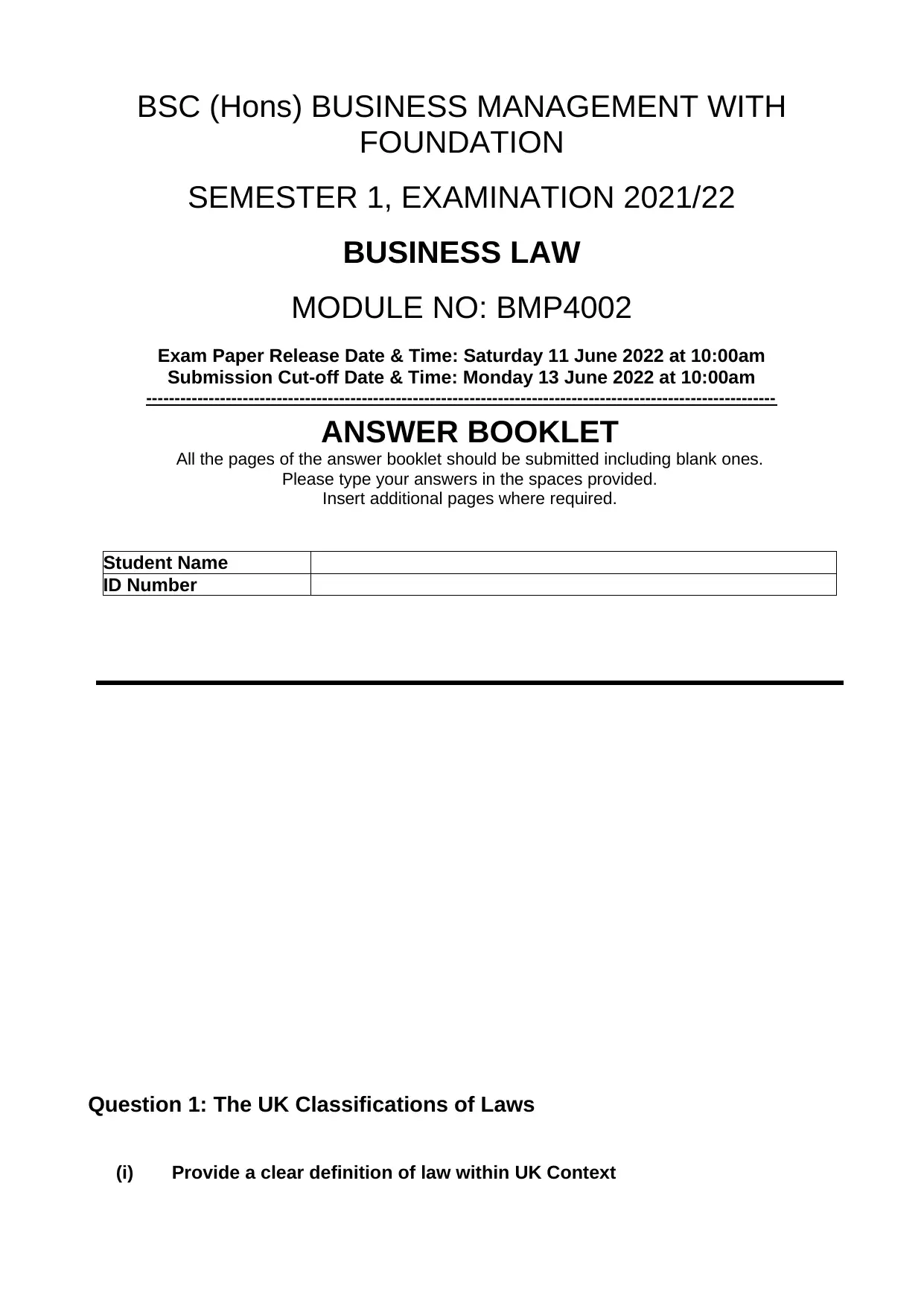
BSC (Hons) BUSINESS MANAGEMENT WITH
FOUNDATION
SEMESTER 1, EXAMINATION 2021/22
BUSINESS LAW
MODULE NO: BMP4002
Exam Paper Release Date & Time: Saturday 11 June 2022 at 10:00am
Submission Cut-off Date & Time: Monday 13 June 2022 at 10:00am
---------------------------------------------------------------------------------------------------------------
ANSWER BOOKLET
All the pages of the answer booklet should be submitted including blank ones.
Please type your answers in the spaces provided.
Insert additional pages where required.
Student Name
ID Number
Question 1: The UK Classifications of Laws
(i) Provide a clear definition of law within UK Context
FOUNDATION
SEMESTER 1, EXAMINATION 2021/22
BUSINESS LAW
MODULE NO: BMP4002
Exam Paper Release Date & Time: Saturday 11 June 2022 at 10:00am
Submission Cut-off Date & Time: Monday 13 June 2022 at 10:00am
---------------------------------------------------------------------------------------------------------------
ANSWER BOOKLET
All the pages of the answer booklet should be submitted including blank ones.
Please type your answers in the spaces provided.
Insert additional pages where required.
Student Name
ID Number
Question 1: The UK Classifications of Laws
(i) Provide a clear definition of law within UK Context
Paraphrase This Document
Need a fresh take? Get an instant paraphrase of this document with our AI Paraphraser
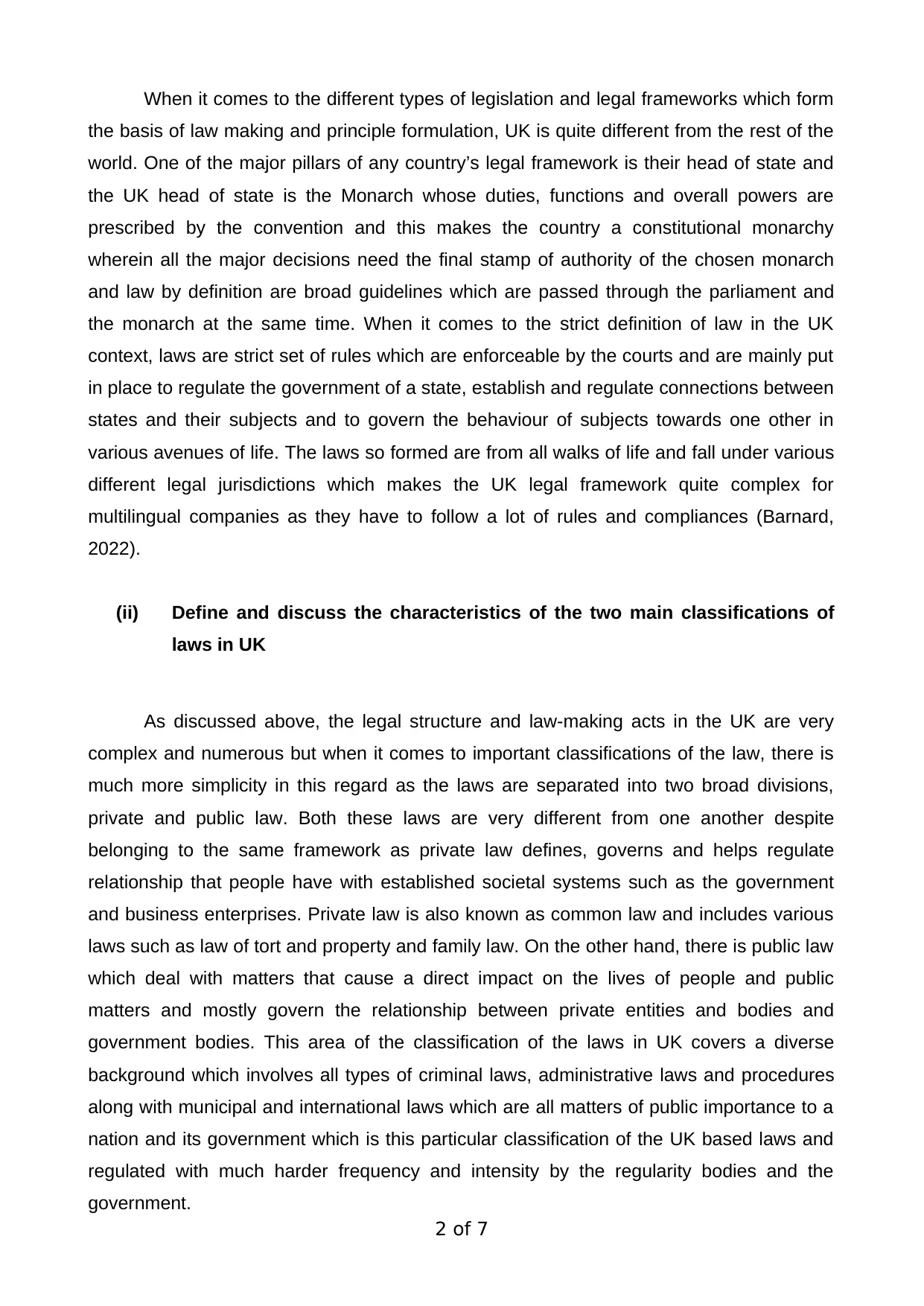
When it comes to the different types of legislation and legal frameworks which form
the basis of law making and principle formulation, UK is quite different from the rest of the
world. One of the major pillars of any country’s legal framework is their head of state and
the UK head of state is the Monarch whose duties, functions and overall powers are
prescribed by the convention and this makes the country a constitutional monarchy
wherein all the major decisions need the final stamp of authority of the chosen monarch
and law by definition are broad guidelines which are passed through the parliament and
the monarch at the same time. When it comes to the strict definition of law in the UK
context, laws are strict set of rules which are enforceable by the courts and are mainly put
in place to regulate the government of a state, establish and regulate connections between
states and their subjects and to govern the behaviour of subjects towards one other in
various avenues of life. The laws so formed are from all walks of life and fall under various
different legal jurisdictions which makes the UK legal framework quite complex for
multilingual companies as they have to follow a lot of rules and compliances (Barnard,
2022).
(ii) Define and discuss the characteristics of the two main classifications of
laws in UK
As discussed above, the legal structure and law-making acts in the UK are very
complex and numerous but when it comes to important classifications of the law, there is
much more simplicity in this regard as the laws are separated into two broad divisions,
private and public law. Both these laws are very different from one another despite
belonging to the same framework as private law defines, governs and helps regulate
relationship that people have with established societal systems such as the government
and business enterprises. Private law is also known as common law and includes various
laws such as law of tort and property and family law. On the other hand, there is public law
which deal with matters that cause a direct impact on the lives of people and public
matters and mostly govern the relationship between private entities and bodies and
government bodies. This area of the classification of the laws in UK covers a diverse
background which involves all types of criminal laws, administrative laws and procedures
along with municipal and international laws which are all matters of public importance to a
nation and its government which is this particular classification of the UK based laws and
regulated with much harder frequency and intensity by the regularity bodies and the
government.
2 of 7
the basis of law making and principle formulation, UK is quite different from the rest of the
world. One of the major pillars of any country’s legal framework is their head of state and
the UK head of state is the Monarch whose duties, functions and overall powers are
prescribed by the convention and this makes the country a constitutional monarchy
wherein all the major decisions need the final stamp of authority of the chosen monarch
and law by definition are broad guidelines which are passed through the parliament and
the monarch at the same time. When it comes to the strict definition of law in the UK
context, laws are strict set of rules which are enforceable by the courts and are mainly put
in place to regulate the government of a state, establish and regulate connections between
states and their subjects and to govern the behaviour of subjects towards one other in
various avenues of life. The laws so formed are from all walks of life and fall under various
different legal jurisdictions which makes the UK legal framework quite complex for
multilingual companies as they have to follow a lot of rules and compliances (Barnard,
2022).
(ii) Define and discuss the characteristics of the two main classifications of
laws in UK
As discussed above, the legal structure and law-making acts in the UK are very
complex and numerous but when it comes to important classifications of the law, there is
much more simplicity in this regard as the laws are separated into two broad divisions,
private and public law. Both these laws are very different from one another despite
belonging to the same framework as private law defines, governs and helps regulate
relationship that people have with established societal systems such as the government
and business enterprises. Private law is also known as common law and includes various
laws such as law of tort and property and family law. On the other hand, there is public law
which deal with matters that cause a direct impact on the lives of people and public
matters and mostly govern the relationship between private entities and bodies and
government bodies. This area of the classification of the laws in UK covers a diverse
background which involves all types of criminal laws, administrative laws and procedures
along with municipal and international laws which are all matters of public importance to a
nation and its government which is this particular classification of the UK based laws and
regulated with much harder frequency and intensity by the regularity bodies and the
government.
2 of 7
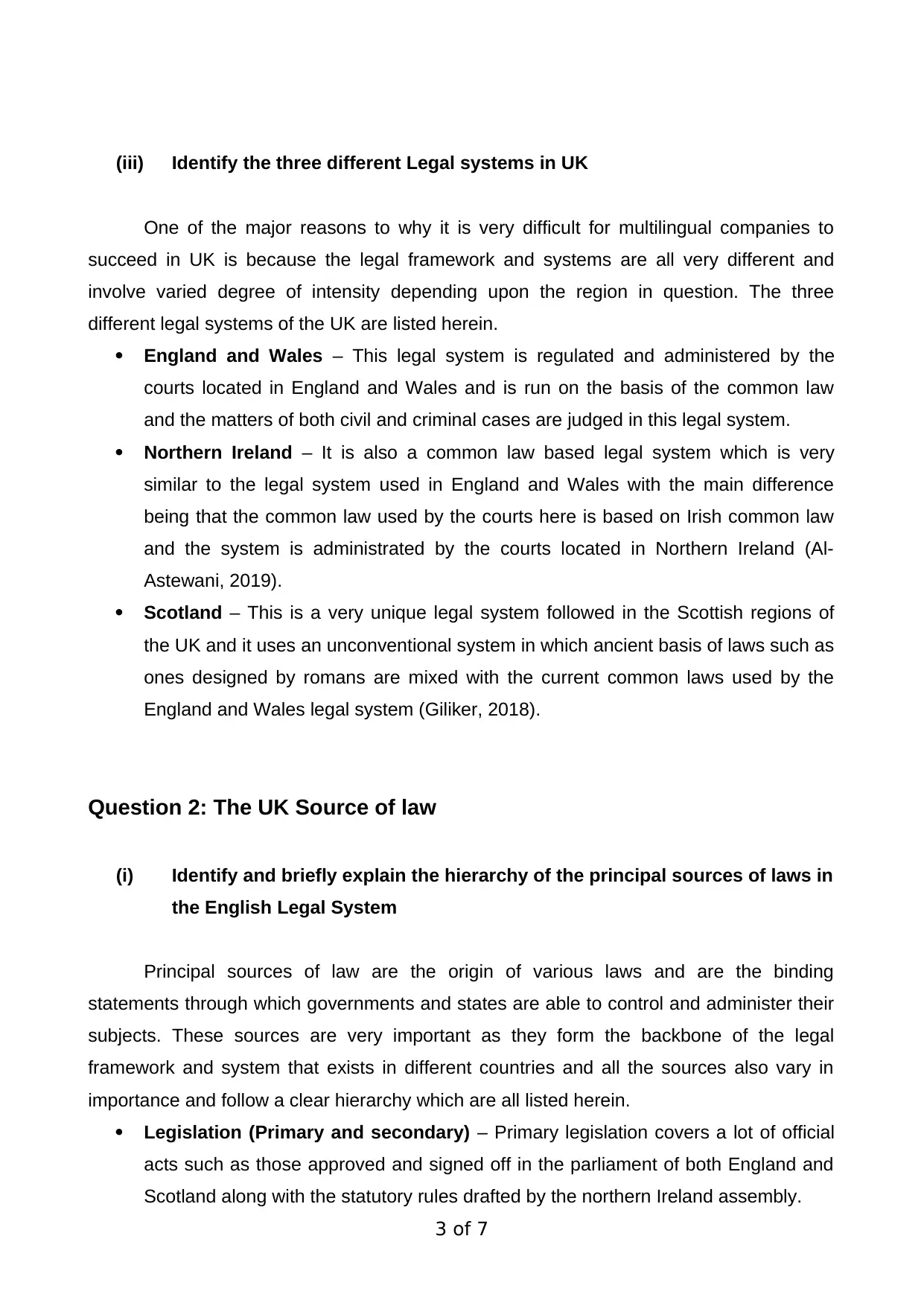
(iii) Identify the three different Legal systems in UK
One of the major reasons to why it is very difficult for multilingual companies to
succeed in UK is because the legal framework and systems are all very different and
involve varied degree of intensity depending upon the region in question. The three
different legal systems of the UK are listed herein.
England and Wales – This legal system is regulated and administered by the
courts located in England and Wales and is run on the basis of the common law
and the matters of both civil and criminal cases are judged in this legal system.
Northern Ireland – It is also a common law based legal system which is very
similar to the legal system used in England and Wales with the main difference
being that the common law used by the courts here is based on Irish common law
and the system is administrated by the courts located in Northern Ireland (Al-
Astewani, 2019).
Scotland – This is a very unique legal system followed in the Scottish regions of
the UK and it uses an unconventional system in which ancient basis of laws such as
ones designed by romans are mixed with the current common laws used by the
England and Wales legal system (Giliker, 2018).
Question 2: The UK Source of law
(i) Identify and briefly explain the hierarchy of the principal sources of laws in
the English Legal System
Principal sources of law are the origin of various laws and are the binding
statements through which governments and states are able to control and administer their
subjects. These sources are very important as they form the backbone of the legal
framework and system that exists in different countries and all the sources also vary in
importance and follow a clear hierarchy which are all listed herein.
Legislation (Primary and secondary) – Primary legislation covers a lot of official
acts such as those approved and signed off in the parliament of both England and
Scotland along with the statutory rules drafted by the northern Ireland assembly.
3 of 7
One of the major reasons to why it is very difficult for multilingual companies to
succeed in UK is because the legal framework and systems are all very different and
involve varied degree of intensity depending upon the region in question. The three
different legal systems of the UK are listed herein.
England and Wales – This legal system is regulated and administered by the
courts located in England and Wales and is run on the basis of the common law
and the matters of both civil and criminal cases are judged in this legal system.
Northern Ireland – It is also a common law based legal system which is very
similar to the legal system used in England and Wales with the main difference
being that the common law used by the courts here is based on Irish common law
and the system is administrated by the courts located in Northern Ireland (Al-
Astewani, 2019).
Scotland – This is a very unique legal system followed in the Scottish regions of
the UK and it uses an unconventional system in which ancient basis of laws such as
ones designed by romans are mixed with the current common laws used by the
England and Wales legal system (Giliker, 2018).
Question 2: The UK Source of law
(i) Identify and briefly explain the hierarchy of the principal sources of laws in
the English Legal System
Principal sources of law are the origin of various laws and are the binding
statements through which governments and states are able to control and administer their
subjects. These sources are very important as they form the backbone of the legal
framework and system that exists in different countries and all the sources also vary in
importance and follow a clear hierarchy which are all listed herein.
Legislation (Primary and secondary) – Primary legislation covers a lot of official
acts such as those approved and signed off in the parliament of both England and
Scotland along with the statutory rules drafted by the northern Ireland assembly.
3 of 7
⊘ This is a preview!⊘
Do you want full access?
Subscribe today to unlock all pages.

Trusted by 1+ million students worldwide
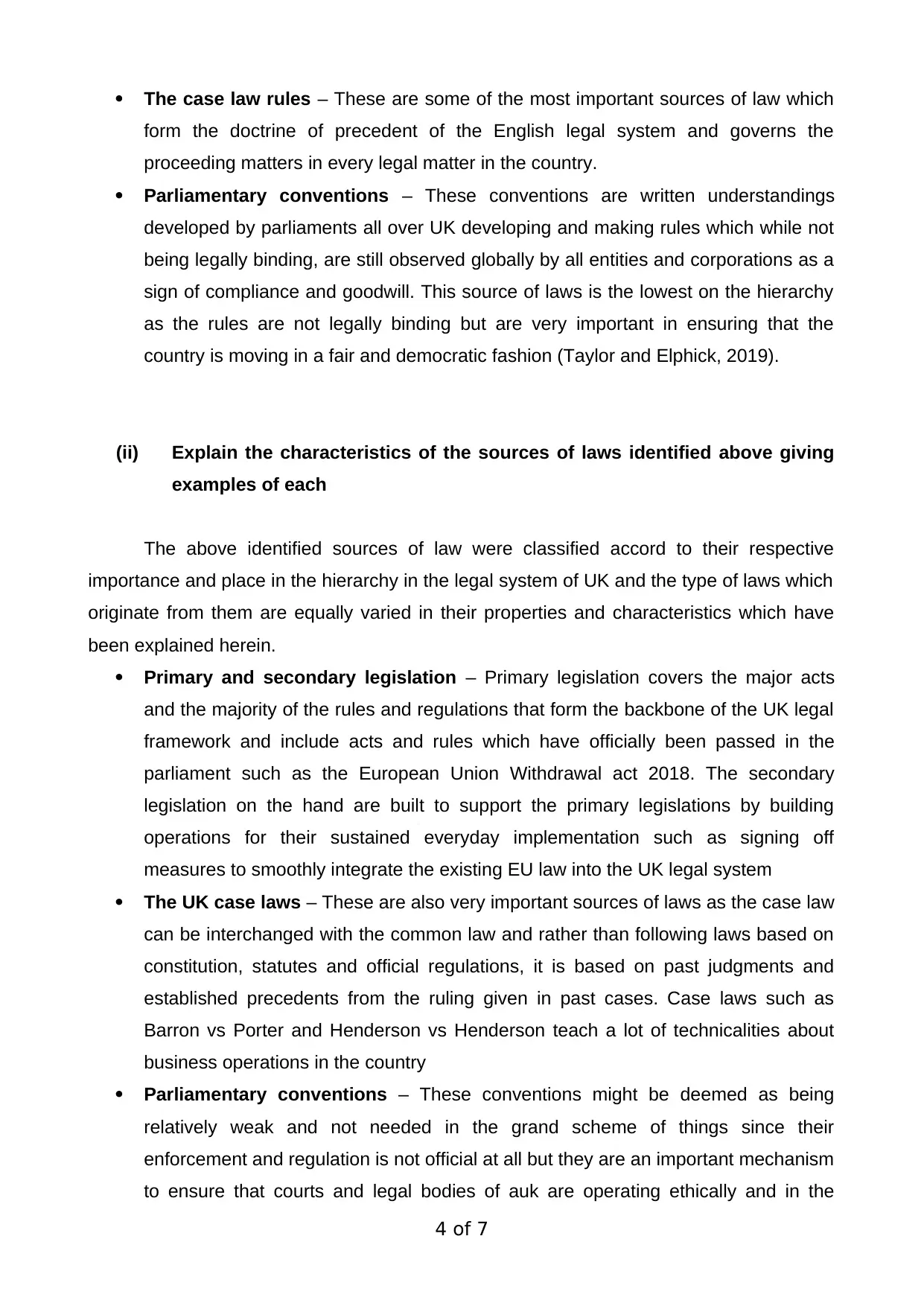
The case law rules – These are some of the most important sources of law which
form the doctrine of precedent of the English legal system and governs the
proceeding matters in every legal matter in the country.
Parliamentary conventions – These conventions are written understandings
developed by parliaments all over UK developing and making rules which while not
being legally binding, are still observed globally by all entities and corporations as a
sign of compliance and goodwill. This source of laws is the lowest on the hierarchy
as the rules are not legally binding but are very important in ensuring that the
country is moving in a fair and democratic fashion (Taylor and Elphick, 2019).
(ii) Explain the characteristics of the sources of laws identified above giving
examples of each
The above identified sources of law were classified accord to their respective
importance and place in the hierarchy in the legal system of UK and the type of laws which
originate from them are equally varied in their properties and characteristics which have
been explained herein.
Primary and secondary legislation – Primary legislation covers the major acts
and the majority of the rules and regulations that form the backbone of the UK legal
framework and include acts and rules which have officially been passed in the
parliament such as the European Union Withdrawal act 2018. The secondary
legislation on the hand are built to support the primary legislations by building
operations for their sustained everyday implementation such as signing off
measures to smoothly integrate the existing EU law into the UK legal system
The UK case laws – These are also very important sources of laws as the case law
can be interchanged with the common law and rather than following laws based on
constitution, statutes and official regulations, it is based on past judgments and
established precedents from the ruling given in past cases. Case laws such as
Barron vs Porter and Henderson vs Henderson teach a lot of technicalities about
business operations in the country
Parliamentary conventions – These conventions might be deemed as being
relatively weak and not needed in the grand scheme of things since their
enforcement and regulation is not official at all but they are an important mechanism
to ensure that courts and legal bodies of auk are operating ethically and in the
4 of 7
form the doctrine of precedent of the English legal system and governs the
proceeding matters in every legal matter in the country.
Parliamentary conventions – These conventions are written understandings
developed by parliaments all over UK developing and making rules which while not
being legally binding, are still observed globally by all entities and corporations as a
sign of compliance and goodwill. This source of laws is the lowest on the hierarchy
as the rules are not legally binding but are very important in ensuring that the
country is moving in a fair and democratic fashion (Taylor and Elphick, 2019).
(ii) Explain the characteristics of the sources of laws identified above giving
examples of each
The above identified sources of law were classified accord to their respective
importance and place in the hierarchy in the legal system of UK and the type of laws which
originate from them are equally varied in their properties and characteristics which have
been explained herein.
Primary and secondary legislation – Primary legislation covers the major acts
and the majority of the rules and regulations that form the backbone of the UK legal
framework and include acts and rules which have officially been passed in the
parliament such as the European Union Withdrawal act 2018. The secondary
legislation on the hand are built to support the primary legislations by building
operations for their sustained everyday implementation such as signing off
measures to smoothly integrate the existing EU law into the UK legal system
The UK case laws – These are also very important sources of laws as the case law
can be interchanged with the common law and rather than following laws based on
constitution, statutes and official regulations, it is based on past judgments and
established precedents from the ruling given in past cases. Case laws such as
Barron vs Porter and Henderson vs Henderson teach a lot of technicalities about
business operations in the country
Parliamentary conventions – These conventions might be deemed as being
relatively weak and not needed in the grand scheme of things since their
enforcement and regulation is not official at all but they are an important mechanism
to ensure that courts and legal bodies of auk are operating ethically and in the
4 of 7
Paraphrase This Document
Need a fresh take? Get an instant paraphrase of this document with our AI Paraphraser
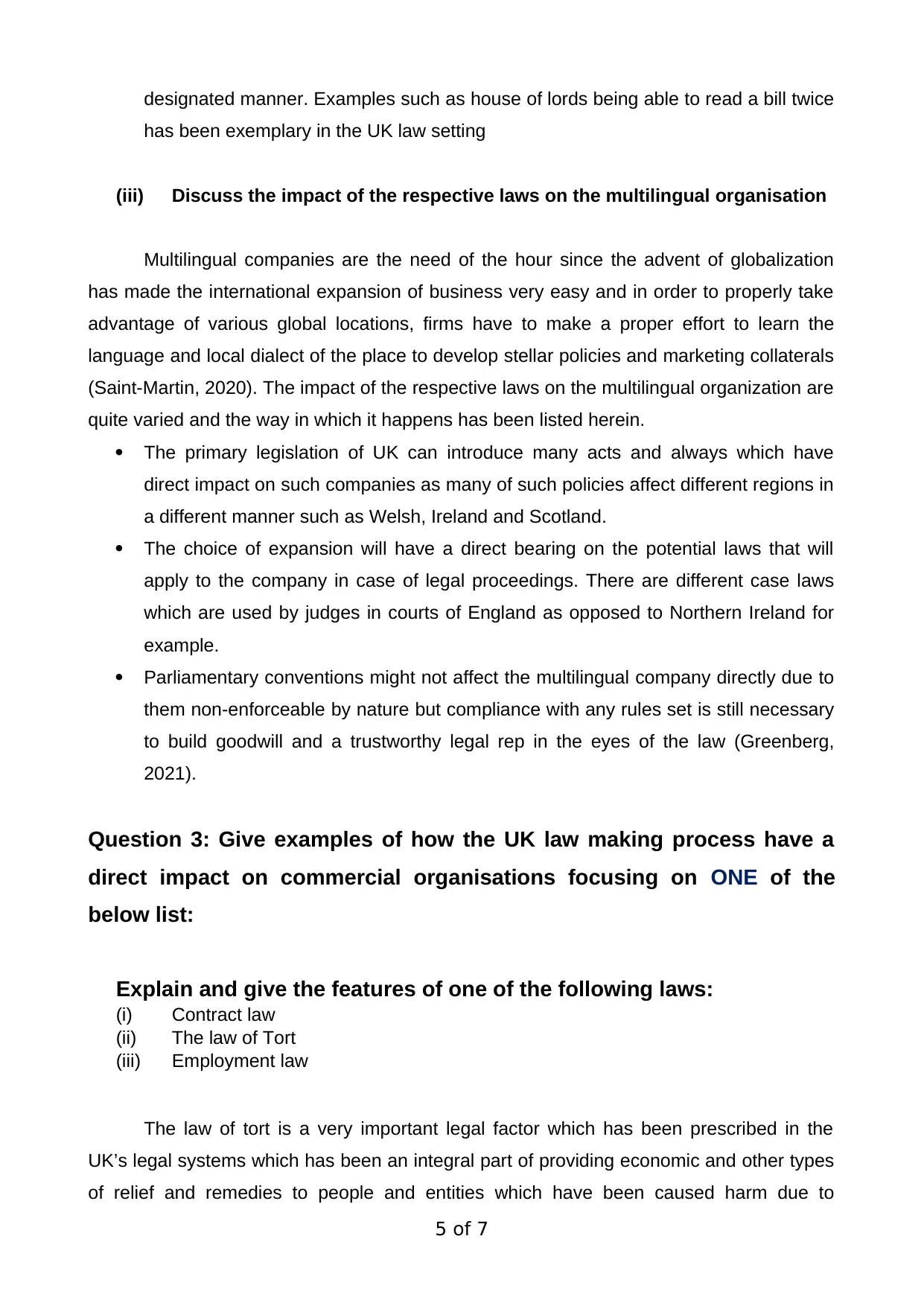
designated manner. Examples such as house of lords being able to read a bill twice
has been exemplary in the UK law setting
(iii) Discuss the impact of the respective laws on the multilingual organisation
Multilingual companies are the need of the hour since the advent of globalization
has made the international expansion of business very easy and in order to properly take
advantage of various global locations, firms have to make a proper effort to learn the
language and local dialect of the place to develop stellar policies and marketing collaterals
(Saint-Martin, 2020). The impact of the respective laws on the multilingual organization are
quite varied and the way in which it happens has been listed herein.
The primary legislation of UK can introduce many acts and always which have
direct impact on such companies as many of such policies affect different regions in
a different manner such as Welsh, Ireland and Scotland.
The choice of expansion will have a direct bearing on the potential laws that will
apply to the company in case of legal proceedings. There are different case laws
which are used by judges in courts of England as opposed to Northern Ireland for
example.
Parliamentary conventions might not affect the multilingual company directly due to
them non-enforceable by nature but compliance with any rules set is still necessary
to build goodwill and a trustworthy legal rep in the eyes of the law (Greenberg,
2021).
Question 3: Give examples of how the UK law making process have a
direct impact on commercial organisations focusing on ONE of the
below list:
Explain and give the features of one of the following laws:
(i) Contract law
(ii) The law of Tort
(iii) Employment law
The law of tort is a very important legal factor which has been prescribed in the
UK’s legal systems which has been an integral part of providing economic and other types
of relief and remedies to people and entities which have been caused harm due to
5 of 7
has been exemplary in the UK law setting
(iii) Discuss the impact of the respective laws on the multilingual organisation
Multilingual companies are the need of the hour since the advent of globalization
has made the international expansion of business very easy and in order to properly take
advantage of various global locations, firms have to make a proper effort to learn the
language and local dialect of the place to develop stellar policies and marketing collaterals
(Saint-Martin, 2020). The impact of the respective laws on the multilingual organization are
quite varied and the way in which it happens has been listed herein.
The primary legislation of UK can introduce many acts and always which have
direct impact on such companies as many of such policies affect different regions in
a different manner such as Welsh, Ireland and Scotland.
The choice of expansion will have a direct bearing on the potential laws that will
apply to the company in case of legal proceedings. There are different case laws
which are used by judges in courts of England as opposed to Northern Ireland for
example.
Parliamentary conventions might not affect the multilingual company directly due to
them non-enforceable by nature but compliance with any rules set is still necessary
to build goodwill and a trustworthy legal rep in the eyes of the law (Greenberg,
2021).
Question 3: Give examples of how the UK law making process have a
direct impact on commercial organisations focusing on ONE of the
below list:
Explain and give the features of one of the following laws:
(i) Contract law
(ii) The law of Tort
(iii) Employment law
The law of tort is a very important legal factor which has been prescribed in the
UK’s legal systems which has been an integral part of providing economic and other types
of relief and remedies to people and entities which have been caused harm due to
5 of 7
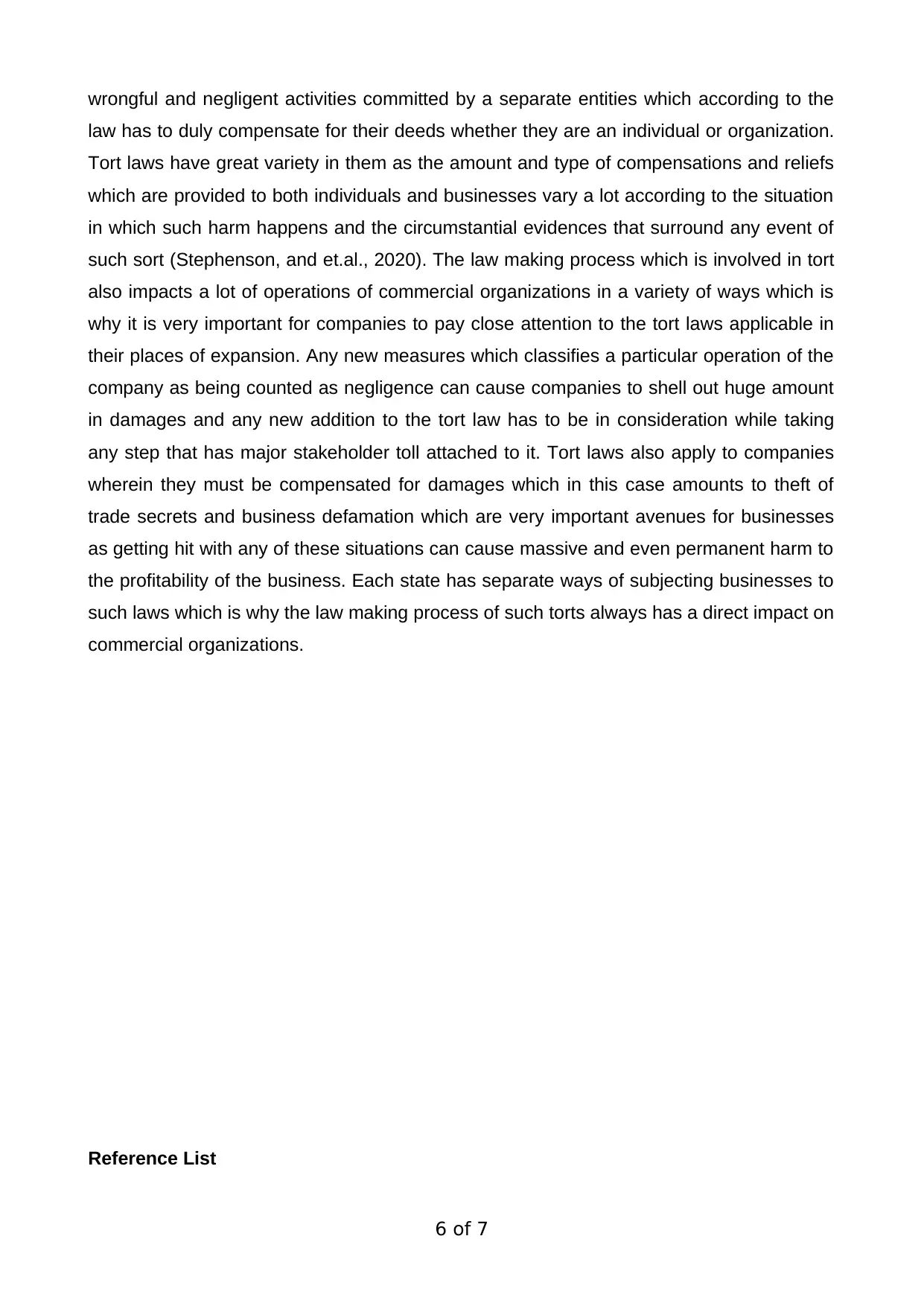
wrongful and negligent activities committed by a separate entities which according to the
law has to duly compensate for their deeds whether they are an individual or organization.
Tort laws have great variety in them as the amount and type of compensations and reliefs
which are provided to both individuals and businesses vary a lot according to the situation
in which such harm happens and the circumstantial evidences that surround any event of
such sort (Stephenson, and et.al., 2020). The law making process which is involved in tort
also impacts a lot of operations of commercial organizations in a variety of ways which is
why it is very important for companies to pay close attention to the tort laws applicable in
their places of expansion. Any new measures which classifies a particular operation of the
company as being counted as negligence can cause companies to shell out huge amount
in damages and any new addition to the tort law has to be in consideration while taking
any step that has major stakeholder toll attached to it. Tort laws also apply to companies
wherein they must be compensated for damages which in this case amounts to theft of
trade secrets and business defamation which are very important avenues for businesses
as getting hit with any of these situations can cause massive and even permanent harm to
the profitability of the business. Each state has separate ways of subjecting businesses to
such laws which is why the law making process of such torts always has a direct impact on
commercial organizations.
Reference List
6 of 7
law has to duly compensate for their deeds whether they are an individual or organization.
Tort laws have great variety in them as the amount and type of compensations and reliefs
which are provided to both individuals and businesses vary a lot according to the situation
in which such harm happens and the circumstantial evidences that surround any event of
such sort (Stephenson, and et.al., 2020). The law making process which is involved in tort
also impacts a lot of operations of commercial organizations in a variety of ways which is
why it is very important for companies to pay close attention to the tort laws applicable in
their places of expansion. Any new measures which classifies a particular operation of the
company as being counted as negligence can cause companies to shell out huge amount
in damages and any new addition to the tort law has to be in consideration while taking
any step that has major stakeholder toll attached to it. Tort laws also apply to companies
wherein they must be compensated for damages which in this case amounts to theft of
trade secrets and business defamation which are very important avenues for businesses
as getting hit with any of these situations can cause massive and even permanent harm to
the profitability of the business. Each state has separate ways of subjecting businesses to
such laws which is why the law making process of such torts always has a direct impact on
commercial organizations.
Reference List
6 of 7
⊘ This is a preview!⊘
Do you want full access?
Subscribe today to unlock all pages.

Trusted by 1+ million students worldwide
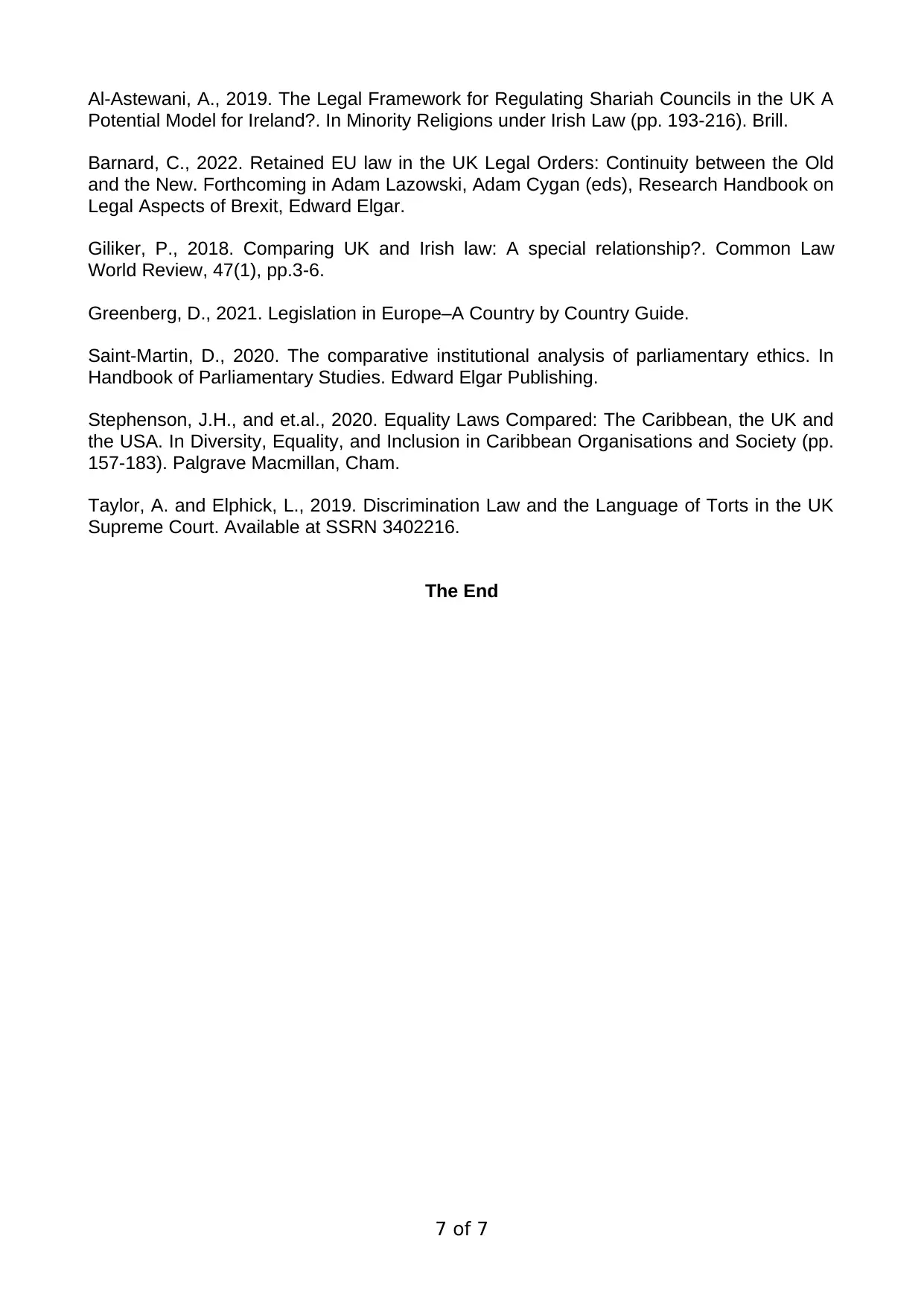
Al-Astewani, A., 2019. The Legal Framework for Regulating Shariah Councils in the UK A
Potential Model for Ireland?. In Minority Religions under Irish Law (pp. 193-216). Brill.
Barnard, C., 2022. Retained EU law in the UK Legal Orders: Continuity between the Old
and the New. Forthcoming in Adam Lazowski, Adam Cygan (eds), Research Handbook on
Legal Aspects of Brexit, Edward Elgar.
Giliker, P., 2018. Comparing UK and Irish law: A special relationship?. Common Law
World Review, 47(1), pp.3-6.
Greenberg, D., 2021. Legislation in Europe–A Country by Country Guide.
Saint-Martin, D., 2020. The comparative institutional analysis of parliamentary ethics. In
Handbook of Parliamentary Studies. Edward Elgar Publishing.
Stephenson, J.H., and et.al., 2020. Equality Laws Compared: The Caribbean, the UK and
the USA. In Diversity, Equality, and Inclusion in Caribbean Organisations and Society (pp.
157-183). Palgrave Macmillan, Cham.
Taylor, A. and Elphick, L., 2019. Discrimination Law and the Language of Torts in the UK
Supreme Court. Available at SSRN 3402216.
The End
7 of 7
Potential Model for Ireland?. In Minority Religions under Irish Law (pp. 193-216). Brill.
Barnard, C., 2022. Retained EU law in the UK Legal Orders: Continuity between the Old
and the New. Forthcoming in Adam Lazowski, Adam Cygan (eds), Research Handbook on
Legal Aspects of Brexit, Edward Elgar.
Giliker, P., 2018. Comparing UK and Irish law: A special relationship?. Common Law
World Review, 47(1), pp.3-6.
Greenberg, D., 2021. Legislation in Europe–A Country by Country Guide.
Saint-Martin, D., 2020. The comparative institutional analysis of parliamentary ethics. In
Handbook of Parliamentary Studies. Edward Elgar Publishing.
Stephenson, J.H., and et.al., 2020. Equality Laws Compared: The Caribbean, the UK and
the USA. In Diversity, Equality, and Inclusion in Caribbean Organisations and Society (pp.
157-183). Palgrave Macmillan, Cham.
Taylor, A. and Elphick, L., 2019. Discrimination Law and the Language of Torts in the UK
Supreme Court. Available at SSRN 3402216.
The End
7 of 7
1 out of 7
Related Documents
Your All-in-One AI-Powered Toolkit for Academic Success.
+13062052269
info@desklib.com
Available 24*7 on WhatsApp / Email
![[object Object]](/_next/static/media/star-bottom.7253800d.svg)
Unlock your academic potential
Copyright © 2020–2025 A2Z Services. All Rights Reserved. Developed and managed by ZUCOL.


